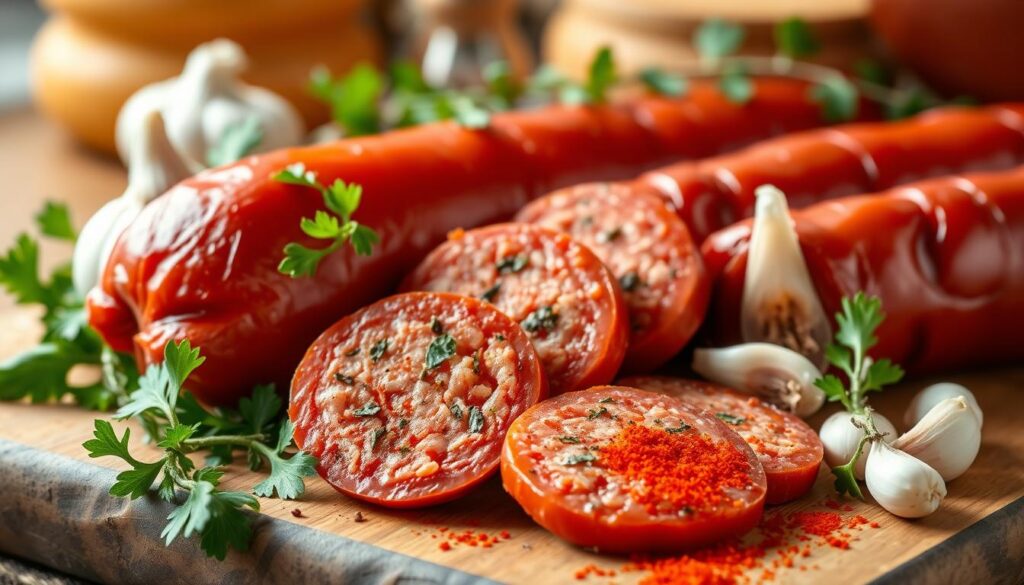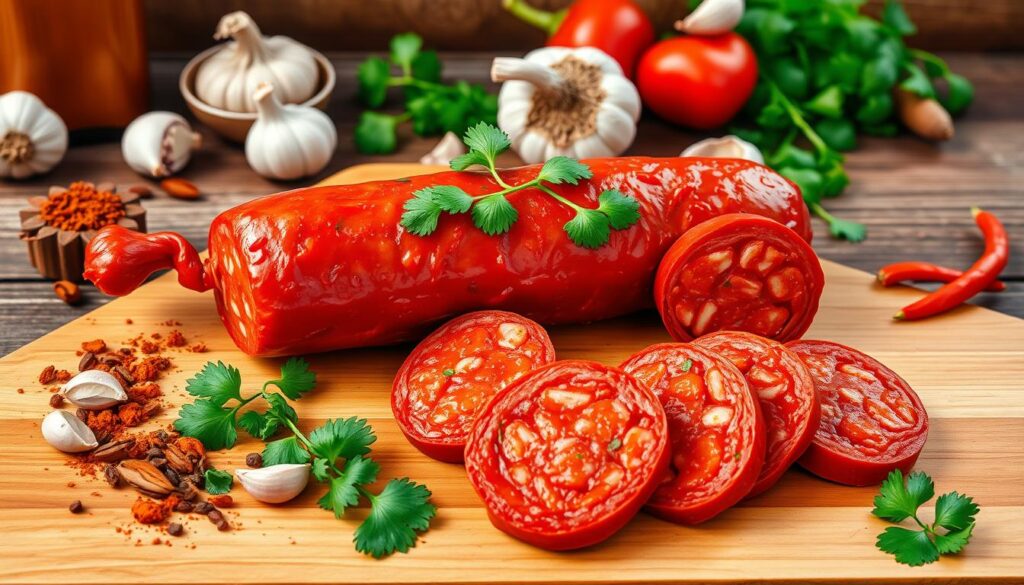
My first time trying Spanish pork sausage was in a small tapas bar in Barcelona. The rich colors and amazing smell caught my attention. I wondered, “Is Spanish style chorizo spicy?” as I took my first bite. It was a flavor that changed how I see sausage forever.
Spanish chorizo is more than just a sausage. It’s a journey for your taste buds. Unlike Mexican chorizo, Spanish chorizo has a more complex spice. It can be mild to moderately hot, depending on how it’s made and where it’s from.
Exploring Spanish chorizo opens up a world of flavors and traditions. You’ll discover why it’s a favorite in Spanish food. Get ready to dive into the delicious world of this iconic Spanish pork sausage.
Key Takeaways
- Spanish chorizo offers a range of spice levels
- Regional variations impact the sausage’s heat
- Paprika plays a crucial role in chorizo’s flavor
- Not all Spanish chorizo is intensely spicy
- Cooking method can influence spice perception
Understanding Spanish Chorizo
Spanish chorizo is a beloved culinary treasure that brings rich flavors to kitchens around the world. This distinctive sausage is a cornerstone of Spanish cuisine. It offers a unique taste experience that goes beyond ordinary meat products.

What Exactly is Chorizo?
Chorizo is a flavorful pork sausage deeply rooted in Spanish culinary traditions. It stands out for its vibrant red color and intense flavor. The types of chorizo vary widely, each representing different regional specialties and cooking techniques.
Exploring Types of Chorizo
- Chorizo Dulce: A mild, sweet version with less paprika
- Chorizo Picante: A spicy variant with more intense seasoning
- Chorizo Cular: Traditional dry-cured sausage
- Chorizo Fresco: Fresh sausage requiring cooking
Key Ingredients in Spanish Chorizo
The Spanish chorizo ingredients are what make this sausage truly special. It typically includes:
- High-quality pork meat
- Smoked paprika (pimentón)
- Garlic
- Salt
- Various spices
“Chorizo is not just a sausage, it’s a celebration of Spanish culinary heritage.” – Spanish Chef Manuel Rodriguez
Understanding the nuanced world of Spanish chorizo reveals a rich tapestry of flavors, techniques, and regional traditions. These continue to captivate food lovers worldwide.
The Flavor Profile of Spanish Chorizo
Spanish chorizo is a true culinary gem. It offers a rich and complex taste experience. This Spanish pork sausage combines flavors that excite your taste buds and take you to Spain’s lively kitchens.

Distinctive Tastes of Spanish Chorizo
The taste of authentic Spanish chorizo is truly unique. It’s a mix of flavors that sets it apart from other sausages. Chorizo seasoning gives it a special taste with:
- Deep smoky undertones
- Rich, savory meat essence
- Subtle hints of garlic
- Warm, earthy spice notes
How Seasoning Affects Flavor
Chorizo seasoning is key to its flavor. Traditional recipes mix spices carefully. This turns ordinary pork into a culinary masterpiece. The mix usually includes:
- Garlic powder
- Black pepper
- Salt
- Dried herbs
Influence of Paprika
Paprika is the star of Spanish chorizo. It gives the sausage its bright color and a deep, smoky taste. The type of paprika used – sweet, hot, or smoked – changes the flavor a lot.
“Paprika is to chorizo what soul is to music – absolutely essential” – Spanish Culinary Expert
Spiciness Levels in Spanish Chorizo
Exploring spicy chorizo requires knowing about its heat levels. Spanish chorizo has a wide range of spiciness. This varies by region and how it’s made.

The heat of chorizo depends on several factors. These factors greatly affect its spiciness. Not all Spanish chorizos are the same in terms of heat.
Mild vs. Spicy Variations
Spanish chorizo has two main heat levels:
- Mild Chorizo (Chorizo Dulce): It has a gentle, sweet paprika taste
- Spicy Chorizo (Chorizo Picante): It’s full of intense, warming heat
Factors Influencing Spiciness
Several things make chorizo spicy:
- The type and amount of paprika used
- Local spice blends
- The type of pepper in it
Regional Spice Variations
Each Spanish region has its own spicy chorizo. The chorizo heat level can be mild or very hot. This shows the local cooking traditions.
“The true magic of Spanish chorizo lies in its remarkable diversity of flavors and heat.” – Spanish Culinary Expert
Knowing these differences helps you pick the right spicy chorizo. It’s perfect for your taste and cooking adventures.
Common Misconceptions about Spiciness
Many people get confused about the heat level of Spanish chorizo. Knowing the truth about this tasty sausage can help you choose better.
Is All Chorizo Spicy?
Not all Spanish chorizo is spicy. The heat level changes based on several things:
- Region of origin
- Specific recipe
- Ingredient selection
- Manufacturer’s preference
Misunderstanding the Ingredients
Some think all chorizo is very hot. Paprika is key for flavor and heat. But, some use sweet paprika, making it mild and rich.
The Role of Cooking Methods
How you cook Spanish chorizo affects its spiciness. Different ways of cooking change its taste:
| Cooking Method | Spice Intensity Impact |
|---|---|
| Grilling | Enhances natural spices |
| Slow cooking | Mellows out heat |
| Pan-frying | Concentrates flavors |
“Not all chorizo is created equal – explore and discover your perfect spice level!” – Spanish Culinary Experts
By knowing these details, you can pick and cook Spanish chorizo just right for you.
Cooking with Spanish Chorizo
Spanish pork sausage can make any meal special. It’s great for both home cooks and food lovers. Learning how to pair chorizo can make your dishes stand out and wow your guests.
Best Dishes for Spanish Chorizo
Here are some dishes that highlight Spanish chorizo’s rich taste:
- Paella with chorizo and seafood
- Hearty potato and chorizo stew
- Breakfast scrambled eggs with chorizo
- Spanish tapas featuring sliced chorizo
How to Incorporate Chorizo in Recipes
When cooking with Spanish pork sausage, it’s important to know its unique traits. Slice it thinly for salads, dice it for soups, or crumble it into scrambled eggs. The goal is to let its bold flavor be the star without overpowering other tastes.
Pairing Spanish Chorizo with Other Ingredients
Pairing chorizo with other ingredients can be magical. Here are some great matches:
- Potatoes: Create rich, hearty dishes
- Seafood: Adds depth to shellfish recipes
- Eggs: Perfect for breakfast preparations
- Beans: Enhances traditional stews
“Chorizo is not just a sausage, it’s a culinary adventure waiting to happen!” – Spanish Culinary Expert
Remember, Spanish chorizo is already cooked. So, you’re just warming it up and mixing it into your dishes. This makes it easy to use and lets you try new things in the kitchen.
Health Aspects of Consuming Chorizo
Looking into the nutrition of spicy chorizo shows a mix of good and bad. Knowing how Spanish chorizo affects your diet helps you choose better.
Chorizo is full of nutrients, but eating it wisely is important. The traditional Spanish chorizo adds flavor and nutrition to your meals.
Nutritional Breakdown
A typical serving of spicy chorizo has:
- High protein content
- Significant fat percentage
- Essential minerals like iron and zinc
- Vitamin B complex
Potential Health Benefits
The ingredients in Spanish chorizo have special benefits:
- Protein Source: Helps build muscles
- Iron Content: Prevents anemia
- Paprika Benefits: Has antioxidants
Considerations for Spicy Food Lovers
“Moderation is key when enjoying flavorful meats like chorizo.” – Nutrition Expert
Spicy chorizo is tasty but should be eaten in small amounts. It has a lot of saturated fat.
| Nutrient | Amount per 100g | Daily Value % |
|---|---|---|
| Protein | 24g | 48% |
| Total Fat | 30g | 46% |
| Iron | 2.5mg | 14% |
It’s important to balance your diet. Enjoy spicy chorizo as part of a varied meal plan.
Where to Buy Spanish Chorizo
Looking for authentic Spanish pork sausage is an exciting adventure. You’ll want to know where to shop and what makes chorizo special.
Specialty Stores with Authentic Selections
Local specialty food stores are the best place to find real Spanish chorizo. Here are some top spots:
- Gourmet food markets
- European delicatessens
- Artisan butcher shops
- Specialty Spanish import stores
Online Retailers for Premium Chorizo
Online shopping has made finding authentic Spanish chorizo easy. Check out these trusted websites:
- La Tienda – Specializes in Spanish imports
- Amazon Gourmet Food section
- Artisan cheese and charcuterie websites
- Specialty food marketplaces
Recognizing Quality Chorizo Products
When choosing Spanish pork sausage, look for these signs of quality:
- Origin labels from specific Spanish regions
- Detailed ingredient lists
- Protected Designation of Origin (PDO) certifications
- Recommendations from culinary experts
“Authentic Spanish chorizo is a journey of flavor, not just a purchase.” – Culinary Experts
Tips for Choosing the Right Chorizo
Finding the perfect Spanish chorizo is a fun journey. Whether you love spicy or milder tastes, knowing how to pick the right chorizo is key for a great meal.
Exploring Spanish style chorizo needs some insider tips. Knowing what to look for helps you find the chorizo that fits your taste and cooking needs.
Decoding Chorizo Labels
When looking for real Spanish chorizo, watch for these important labels:
- Protected Designation of Origin (PDO) certification
- Region of origin (such as León or Pamplona)
- Ingredient percentage details
- Curing method
Identifying Spice Levels
Is Spanish style chorizo spicy? It depends on the type. Here’s how to tell about chorizo seasoning:
| Spice Indicator | Meaning |
|---|---|
| Picante | Spicy version with more heat |
| Dulce | Mild version with sweet paprika |
| Pimentón | Paprika level indicates potential spiciness |
Understanding Product Descriptions
Reading product descriptions carefully helps you choose the perfect chorizo. Look for specific details about:
- Paprika type (sweet or hot)
- Meat quality
- Aging process
- Recommended uses
“The right chorizo can transform an ordinary meal into a culinary masterpiece.” – Spanish Culinary Experts
Your personal taste is the most important when picking chorizo. Don’t hesitate to ask questions at specialty stores or try samples to find your perfect match.
Frequently Asked Questions about Spanish Chorizo
Spanish chorizo can spark many questions among food enthusiasts. Knowing the details about these types of chorizo helps you make better choices in the kitchen. We’ll cover common questions about this tasty sausage, from gluten content to storage.
Is Spanish Chorizo Gluten-Free?
Traditional Spanish chorizo is made from pork, paprika, garlic, and salt. Most of these are naturally gluten-free. But, always check the labels. Some processed chorizos might have gluten due to wheat-based fillers or additives.
Can I Substitute Spanish for Mexican Chorizo?
Spanish and Mexican chorizo are quite different. Spanish chorizo is cured and ready to eat, with a firm texture. Mexican chorizo, on the other hand, is raw and needs to be cooked. Swapping them will change your dish’s taste and cooking method.
How Should Chorizo Be Stored?
Storing chorizo properly is key to keeping its quality. Cured chorizos should be stored in a cool, dry place before opening. Once cut, wrap it tightly and refrigerate. Use it within a week for the best flavor and to avoid spoilage.
